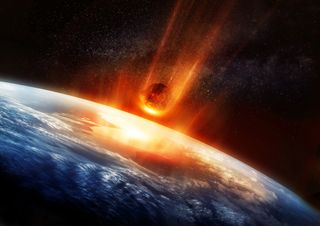Ancient Meteor Strike Triggered Eruptions Lasting Up to a Million Years

A giant meteor impact on Earth nearly 2 billion years ago triggered more explosive and long-lived volcanic eruptions than previously thought, a new study finds.
This finding sheds light on how meteor bombardment may have dramatically shaped the evolution of the early Earth, researchers in the new study said.
Meteor strikes have left giant craters all over Earth. For instance, the cosmic impact that scientists think ended the age of dinosaurs about 66 million years ago left behind a crater more than 110 miles (180 kilometers) wide near the town of Chicxulub (CHEEK-sheh-loob) in Mexico. [In Photos: The Impact Craters of North America]
Gargantuan craters are seen pockmarking the rest of the solar system as well. Recent studies of such impact craters on the moon, Mercury, Venus and Mars suggested that meteor strikes could trigger volcanic activity.
However, over the course of millions of years, geological activity has eradicated the vast majority of ancient impact craters on Earth. This has limited research into whether meteor strikes could also set off volcanism on Earth, said study senior author Balz Kamber, a geochemist in Trinity College Dublin in Ireland, and his colleagues.
To see what effects giant impacts might have had on the surface of the Earth, the researchers analyzed one of the oldest meteor craters on the planet, the 1.85-billion-year-old Sudbury basin in Canada. It's also the second-largest and best-preserved crater on Earth, measuring about 93 to 161 miles (150 to 260 km) in diameter. A 2015 study estimated that the crater may have been created by a comet about 9.3 miles (15 km) wide.
From 2013 to 2014, the scientists in the new study collected samples from the 0.93-mile-thick (1.5 km) layer of rock that filled the Sudbury crater. Although the crater is easy for researchers to get to, "there are lots and lots of blackflies in the spring, and later mosquitoes, and in the summer, there are a lot of blueberries, and so a lot of black bears," Kamber said.
Sign up for the Live Science daily newsletter now
Get the world’s most fascinating discoveries delivered straight to your inbox.
The scientists examined 139 samples from 15 locations in the crater. Their analysis suggested that this material not only consisted of rock that had melted from the heat of the impact, but was also peppered with tiny fragments of volcanic rock.
The researchers noted that these volcanic rocks often had very distinctive angular shapes resembling crab claws. These shapes form when gas bubbles expand in molten rock that then catastrophically explodes, a feature of violent eruptions involving water, such as those seen under glaciers in Iceland, the researchers explained. They said these angular Sudbury volcanic rocks likely arose when seawater flooded the crater floor, either gradually or suddenly.
In addition, the scientists found that the composition of these volcanic-rock fragments varied in nature, with some originating from molten crust and others from "a deeper magma source," Kamber said. These findings suggested that the volcanic activity that created these rocks changed over time and was therefore prolonged, he said.
How long might this meteor-triggered volcanism have lasted? "I think 1 million years would have been an upper limit," Kamber said. "Hundreds of thousands of years is a more reasonable estimate."
These findings shed light on how meteors could have influenced the evolution of early Earth, Kamber said.
"About 3.8 billion to 4 billion years ago, we know the inner solar system experienced heavy bombardment from impactors," Kamber said. The oldest rocks on the planet coincide with the last peak of this bombardment, suggesting that "the older rocks on Earth were somehow destroyed by this bombardment," he said. "The bombardment alone would not have done sufficient damage to have caused the comprehensive loss of primordial rocks on Earth, but if that bombardment also triggered additional eruptions, that could have buried the primordial rocks and plowed them back into the mantle."
The scientists said they are now investigating whether the deep magma they detected in the crater came from the deep crust or from the mantle layer just beneath Earth's crust. They detailed their findings April 22 in the Journal of Geophysical Research: Planets.
Original article on Live Science.

